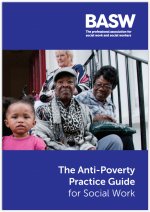
The Anti-Poverty Practice Guide for Social Work
Omschrijving
BASW (Anti-armoede praktijkgids voor sociaal werkers)
Overview of contents
The contents of the Guide reflect the findings from the UK-wide consultations within BASW, which have been analysed within the context of existing literature on poverty and social work.
The Guide has a practice-focus and is organised in a manner which social workers can adopt and incorporate into their everyday work.
Section 2 addresses theories of poverty and how the lived experience of deprivation impacts on peoples sense of worth, with knock-on effects on their mental health, their parenting, and participation
in society. The key message of this section is that while poverty can be operationalised through ‘objective’ data and examination of peoples ’access to material resources, social workers should adopt
a multi-dimensional approach, which emphasises equal rights to participation in society.
Section 3 discusses themes from the consultations with BASW members and activists, identifying the effects of on-going austerity on the ability of social workers to meet peoples ’needs. It explains
the different understandings of poverty used by social workers alongside the views of activists from ATD Fourth World. The key learning from this section is that currently, poverty is such a common
feature of the experiences of people that, it can sometimes not be noticed and addressed by social workers. For this reason, it is important for social workers to understand multi-dimensional theories
of poverty – social, cultural and relational - and their corresponding professional and ethical responsibilities to people living in poverty.
Section 4 proposes practical, skills-based approaches that can assist social workers in their work with people experiencing poverty. This section explains the need for social workers to understand the
communities they work in, and the importance of relationship-based approaches in anti-poverty practice. This part of the Guide provides an analytic thread between the literature on poverty, the
messages from social workers and activists, and the skills and knowledge required for anti-poverty practice.
Section 5 provides useful resources for readers to use in self-directed learning, group discussions, and training on anti-poverty practice
